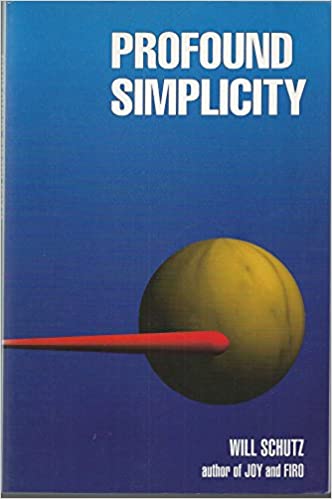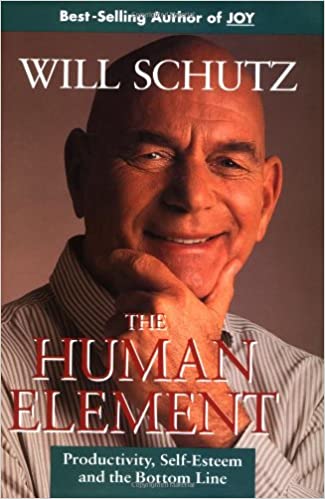Background
William Schutz was born on December 19, 1925, in Illinois, United States.

Los Angeles, CA 90095, United States
Schutz earned his Doctor of Philosophy from the University of California, Los Angeles in 1951.

(A fifteen-year-old boy struggles to survive and come to t...)
A fifteen-year-old boy struggles to survive and come to terms with inner conflicts in the desperate world of the Depression.
https://www.amazon.com/Profound-Simplicity-Foundations-Social-Philosophy/dp/0893840661/ref=sr_1_1?dchild=1&keywords=Profound+Simplicity&qid=1600783239&s=books&sr=1-1
1979

(Shows how to enhance our performance and improve our orga...)
Shows how to enhance our performance and improve our organizations by developing healthier self-concepts of ourselves and in others. A personal development and leadership guide to creating a work environment where self-determination and openness are the rules, offers strategies for heightening our awareness of ourselves and others as a key factor in shaping our relationships to work. Offers a field-tested approach to improving organizational effectiveness, introducing innovative tools and exercises - including the concordance model of decision making, the Team Compatibility Index for team building, the Work Relations Index for improved individual performance, and the leader as completer concept of leadership - to promote creativity and openness at work.
https://www.amazon.com/Human-Element-Productivity-Self-Esteem-Management/dp/1555426123/ref=sr_1_1?dchild=1&keywords=the+Human+Element%3A+Productivity%2C+Self-Esteem+and+the+Bottom+Line+schutz&qid=1600786195&s=books&sr=1-1
1994
educator consultant psychologist author
William Schutz was born on December 19, 1925, in Illinois, United States.
Schutz earned his Doctor of Philosophy from the University of California, Los Angeles in 1951.
During the Korean War in 1952, William Schutz was recalled into the United States Navy and did research on understanding and predicting how any given group of men would work together. This resulted in his first book, "FIRO: A Three-Dimensional Theory of Interpersonal Behavior" (1958), which presented the Fundamental Interpersonal Relations Orientation (FIRO) theory and several measuring instruments including FIRO-B, an instrument designed to predict the interaction between two people.
After the Navy, he taught and did research at several institutions including Harvard, the University of Chicago, and the University of California at Berkeley. While he was successful, he also found that he was straining at the edges of traditional techniques.
In the late 1950s, Schutz came into contact with a psychotherapeutic group for young psychiatrists, designed to help them learn more about themselves before they started helping others. As a member of the group, he was admonished to tell the truth, hear feedback from others about how they really felt about him, and open himself to the world of feelings. This was, in his words, "a frightening delight." By the mid-1960s he started to see an intriguing contrast. At the Albert Einstein Medical School in the Bronx, New York, he watched psychiatrists run psychotherapy groups. At the same time, he began to work with the National Training Laboratories (NTL) at Bethel, Maine, conducting T-groups ("T" for training). He found that the work and the results of the T-group leaders, who were viewed as "unqualified" by the traditional-professional viewpoint, more creative, deeper, faster, and more effective than what was being done in the heart of the psychiatric establishment.
Inspired, Schutz studied new techniques in human behavior as much as he could, including psychosynthesis, psychodrama, bioenergetics, Rolfing, and gestalt therapy. Common to all was the use of nonverbal methods, especially movement and imagery. He began to incorporate parts of these non-traditional methods into his own group techniques. In early 1967 he wrote the best-seller, "Joy: Expanding Human Awareness," which summarized the techniques he had been learning, as well as others he had devised, and explained how to use them.
He was still successful in academia and was consulting with various organizations, but he had little energy for his job. So, in late 1967 he moved to Esalen Institute, a growth center in Big Sur, California, as associate-in-residence and director of the residential program, where he was stimulated, excited, and motivated to use his creativity. There he offered encounter groups - workshops incorporating the ideas of T-groups with the experiential methods he had learned. In addition, he studied and experienced a variety of approaches - physical, psychological, and spiritual - for developing the full potential of each person and each interaction between people. While at Esalen, he wrote a number of books including "Here Comes Everybody" (1971), a follow-up to Joy, and "Elements of Encounter" (1973), in which he chronicled the principles of encounter groups.
In 1975, he left Esalen and began to integrate his scientific work with the experiential material he had learned. "Profound Simplicity" (1979), communicated his realization that all the approaches he had studied - encounter groups, imagery, gestalt therapy, psychodrama, acupuncture, bioenergetics, Rolfing, the Feldenkrais method, aikido, and t'ai chi - were all in service of the same thing, a realization of full human potential.
In 1980, using his human-potential experience and his work with FIRO theory and the FIRO scales, he created The Human Element, first tested with organizations such as Kodak, Esso, Ampex, Mattel, United Biscuit, the U.S. Army. From these early experiences, the key principles of truth, choice, and awareness crystallized and the form of The Human Element took shape. In the course of creating this body of work, he revised and expanded the FIRO theory and the FIRO instruments, creating an integrated set of tools called "The Elements of Awareness." These instruments, designed specifically for training, were incorporated into "The Human Element." His last two books cover the content of "The Human Element: The Truth Option" (1984) and "The Human Element" (1994).
From 1980 until 2001 Schutz, with his wife Ailish, created and led an international network of participants and practitioners - individuals, leaders, trainers, consultants, coaches, and organizational development specialists - devoted to the principles of "The Human Element." In 2001 "The Human Element" was purchased by Business Consultants, Inc. of Japan. The Schutz Company, lead by Will's son, Ethan, is the representative of The Human Element in the United States and Canada.
William Schutz was a famous American psychologist. He was the founder of the Fundamental Interpersonal Relations Orientation (FIRO) theory. He is known as the pioneer of the human potential movement. There were training conferences which he led that were based on his theory of interpersonal behavior.
(Shows how to enhance our performance and improve our orga...)
1994(A fifteen-year-old boy struggles to survive and come to t...)
1979William Schultz's theory called the Fundamental Interpersonal Relations Orientation (FIRO). According to this theory, these three needs dimensions of interpersonal relationships are sufficient to explain most interactions between people. Furthermore, the theory states that people typically enter into relationships with others in order to fulfill these basic needs.
The need for inclusion relates to a person's desire to be recognized by others through human interactions and to feel like an active participant in these relations. This is the most basic of the three needs, according to Schutz, and is necessary for healthy existence. The need for control is the next level, which relates to a person's desire to feel like they are having an impact in their social sphere. The last level is the need for openness or affection, which is the desire to be liked or loved by others. Schutz theorizes that people often feel alienated from their surroundings when this need is not properly fulfilled.
William's wife was Ailish Schutz. The couple had a son, Ethan.
